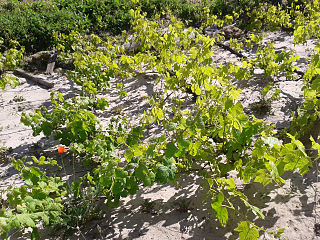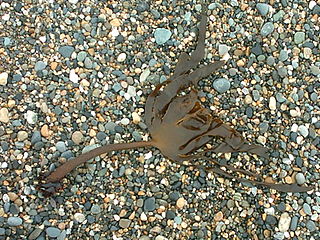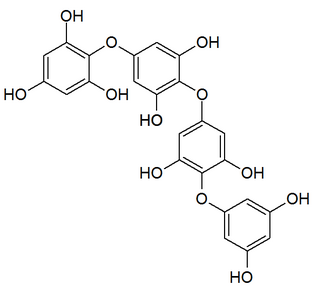
The brown algae, comprising the class Phaeophyceae, are a large group of multicellular algae, including many seaweeds located in colder waters within the Northern Hemisphere. Most brown algae live in marine environments, where they play an important role both as food and as a potential habitat. For instance, Macrocystis, a kelp of the order Laminariales, may reach 60 m (200 ft) in length and forms prominent underwater kelp forests. Kelp forests like these contain a high level of biodiversity. Another example is Sargassum, which creates unique floating mats of seaweed in the tropical waters of the Sargasso Sea that serve as the habitats for many species. Many brown algae, such as members of the order Fucales, commonly grow along rocky seashores. Some members of the class, such as kelps, are used by humans as food.

The Sargasso Sea is a region of the Atlantic Ocean bounded by four currents forming an ocean gyre. Unlike all other regions called seas, it has no land boundaries. It is distinguished from other parts of the Atlantic Ocean by its characteristic brown Sargassum seaweed and often calm blue water. A similar Sargasso sea is not found in the South Atlantic Ocean

Sargassum is a genus of brown macroalgae (seaweed) in the order Fucales. Numerous species are distributed throughout the temperate and tropical oceans of the world, where they generally inhabit shallow water and coral reefs, and the genus is widely known for its planktonic (free-floating) species. Most species within the class Phaeophyceae are predominantly cold-water organisms that benefit from nutrients upwelling, but the genus Sargassum appears to be an exception. Any number of the normally benthic species may take on a planktonic, often pelagic existence after being removed from reefs during rough weather; however, two species have become holopelagic—reproducing vegetatively and never attaching to the seafloor during their lifecycles. The Atlantic Ocean's Sargasso Sea was named after the algae, as it hosts a large amount of Sargassum.

Arame, sea oak is a species of kelp, of the brown algae, best known for its use in Japanese cuisine.
Algaculture is a form of aquaculture involving the farming of species of algae.

Masseira is a unique form of traditional farming practised in Póvoa de Varzim and Esposende in Portugal.

The 1931 census of Palestine was the second census carried out by the authorities of the British Mandate for Palestine. It was carried out on 18 November 1931 under the direction of Major E. Mills after the 1922 census of Palestine. No further census was conducted in Palestine by the British administration.

Ecklonia cava is an edible marine brown alga species found in the ocean off Japan and Korea. It is used as an herbal remedy in the form of an extract called Seanol, a polyphenolic extract, and Ventol, a phlorotannin-rich natural agent. Phlorotannins, such as fucodiphlorethol G, 7-phloro eckol, 6,6'-bieckol, eckol, 8,8'-bieckol, 8,4"'-dieckol and phlorofucofuroeckol A can be isolated from Ecklonia cava. Other components are common sterol derivatives.

Ecklonia is a genus of kelp belonging to the family Lessoniaceae.

Sargassum muticum, commonly known as Japanese wireweed, is a large brown seaweed of the genus Sargassum. It is an invasive seaweed with high growth rate. It has an efficient dispersion thanks to its floats.

Galactolipids are a type of glycolipid whose sugar group is galactose. They differ from glycosphingolipids in that they do not have nitrogen in their composition.

Phlorotannins are a type of tannins found in brown algae such as kelps and rockweeds or sargassacean species, and in a lower amount also in some red algae. Contrary to hydrolysable or condensed tannins, these compounds are oligomers of phloroglucinol (polyphloroglucinols). As they are called tannins, they have the ability to precipitate proteins. It has been noticed that some phlorotannins have the ability to oxidize and form covalent bonds with some proteins. In contrast, under similar experimental conditions three types of terrestrial tannins apparently did not form covalent complexes with proteins.
Ecklonia kurome is a brown alga species in the genus Ecklonia found in the Sea of Japan.

Tetraphlorethol C is a phlorethol-type phlorotannin found in the brown alga Ascophyllum nodosum. chemically, it is a tetramer of 1,2,3,5-Tetrahydroxybenzene

Tetrafucol A is a fucol-type phlorotannin found in the brown algae Ascophyllum nodosum, Analipus japonicus and Scytothamnus australis.

6,6'-Bieckol is an eckol-type phlorotannin found in the brown algae Ecklonia cava and Ecklonia stolonifera.

Lessonia nigrescens, the grey weed or giant grey weed, is a South American kelp species in the genus Lessonia.
Vanillin–HCl staining, can be used to visualize the localisation of tannins in cells.

Fucophlorethol A is a phlorotannin found in the brown alga Fucus vesiculosus.

Bifuhalol is a phlorotannin. The ethanol extract of the brown alga Sargassum ringgoldianum contains phlorotannins of the bifuhalol type, which shows an antioxidative activity.














